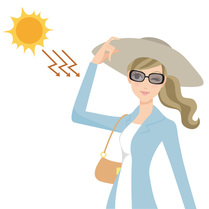Slip slop slap seek slide – be SunSmart!
Use of sunscreens to reduce the risk of sun damage and skin cancer is recommended by dermatologists, cancer specialists, cancer councils and societies, and public health authorities.
But it’s not the whole picture. If you do need or choose to be outdoors, the Cancer Council Australia’s SunSmart program helps you remember the five key sun protection measures:
But it’s not the whole picture. If you do need or choose to be outdoors, the Cancer Council Australia’s SunSmart program helps you remember the five key sun protection measures:
- Slip on protective clothing to cover up skin.
- Slop on sunscreen. Use the right amount of broad spectrum SPF 30 or higher sunscreen to exposed skin. And reapply regularly.
- Slap on a hat. Broad-brimmed is ideal to protect the eyes, face and neck.
- Seek shade, especially in the midday hours or when the UV Index reaches three or higher.
- Slide on sunglasses. UV radiation can damage the eyes in various ways.
Is it ok to tan?
|
No. Whilst many Australians like the appearance of a tan, it is not a sign of good health.
You may remember some advertisements about sun exposure, tanning and skin cancer. For example, the Dark Side of Tanning ads by the Cancer Institute NSW. These ads used slogans such as “tanning is skin calls in trauma”, and “there is nothing healthy about a tan”.[i] Tanning shows that your skin has been damaged by UV radiation. A tan does offer a small amount of protection from sunburn caused by UVB (roughly equivalent to SPF3), but does not protect from skin cancer. A fake tan is a safer alternative to UV radiation exposure if you do want a tanned appearance. However, a fake tan will not provide extra sun protection for your skin so you should continue to Slip Slop Slap Seek Slide! |
|
What about vitamin D?
UV radiation from the sun is not only the highest cause of skin cancer, it is also a great source of vitamin D. Our bodies make vitamin D when exposed to UVB radiation. Vitamin D is important for strong bones and other body functions.
Sensible sun protection should not put you at risk of vitamin D deficiency. Although it is hard to provide guidance on the amount of time your bare skin needs to be exposed to the sun – as this depends on many factors including the time of day, where you live, how much skin is exposed, your skin type, etc – brief exposure during low UV times is safe and healthy.
This is what the Cancer Council Australia says: “In Australia, we need to balance the risk of skin cancer from too much sun exposure with maintaining adequate vitamin D levels. Sensible sun protection does not put people at risk of vitamin D deficiency.”[ii]
Sensible sun protection should not put you at risk of vitamin D deficiency. Although it is hard to provide guidance on the amount of time your bare skin needs to be exposed to the sun – as this depends on many factors including the time of day, where you live, how much skin is exposed, your skin type, etc – brief exposure during low UV times is safe and healthy.
This is what the Cancer Council Australia says: “In Australia, we need to balance the risk of skin cancer from too much sun exposure with maintaining adequate vitamin D levels. Sensible sun protection does not put people at risk of vitamin D deficiency.”[ii]
How can I check my skin for cancer?
|
Early detection of skin cancer is key! The sooner skin cancer is identified the sooner it can be treated. And the better the prognosis. Untreated skin cancer can be deadly.
The first step is to know your skin, so you notice any changes. The second step is to check your skin regularly, so that you pick up any changes. Enlist the help of a mirror, friend or partner for any hard-to-see places. Melanoma can develop even in places where you don’t get much sun, so take off your clothes and have a thorough look everywhere. It is also a good idea to talk to your doctor about your level of risk. And to have your skin checked by a professional as often as your level of risk indicates – or if you are concerned about any spots. For more information on early detection of skin cancer, see www.sunsmart.com.au/skin-cancer/checking-for-skin-cancer. |
What to look for? [iii] Moles:
|
References
[i] © State of New South Wales (Cancer Institute NSW). For current information go to www.cancerinstitute.org.au
[ii] www.cancer.org.au/preventing-cancer/sun-protection/vitamin-d/ (Accessed 12 August 2016)
[iii] www.cancer.org.au/preventing-cancer/sun-protection/check-for-signs-of-skin-cancer.html (Accessed 12 August 2016)
[i] © State of New South Wales (Cancer Institute NSW). For current information go to www.cancerinstitute.org.au
[ii] www.cancer.org.au/preventing-cancer/sun-protection/vitamin-d/ (Accessed 12 August 2016)
[iii] www.cancer.org.au/preventing-cancer/sun-protection/check-for-signs-of-skin-cancer.html (Accessed 12 August 2016)






